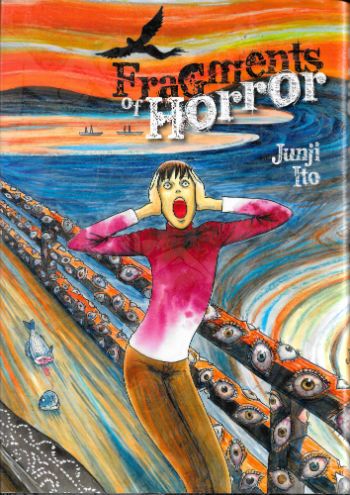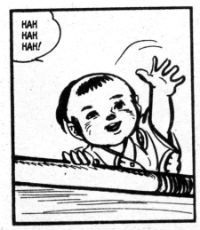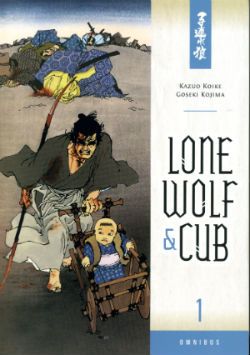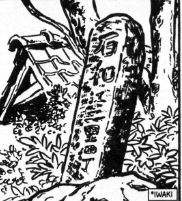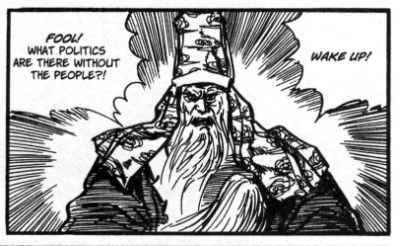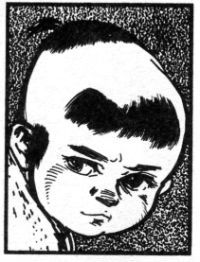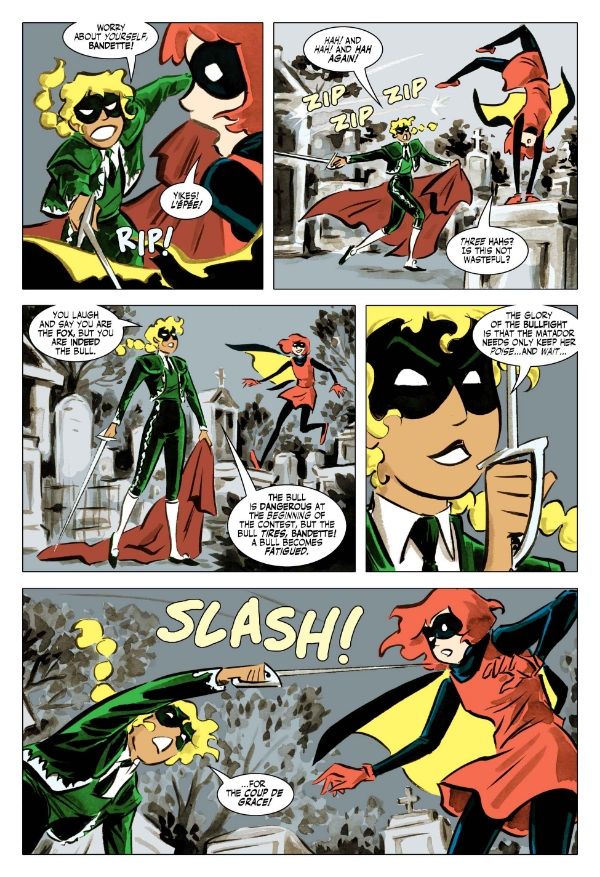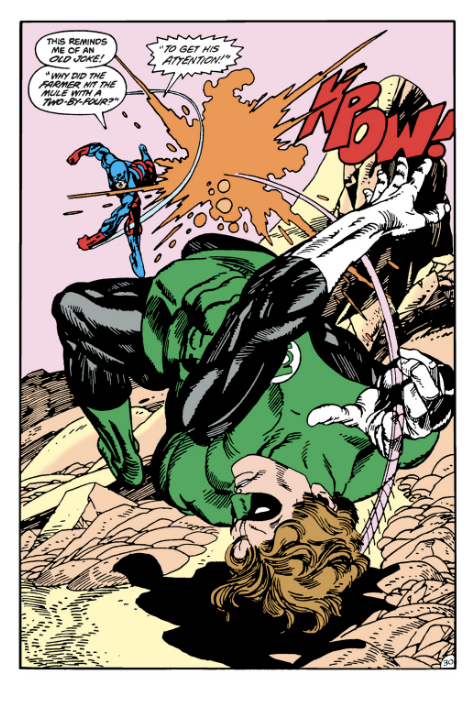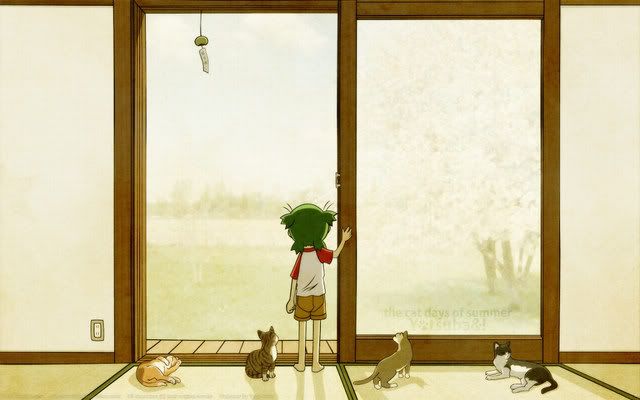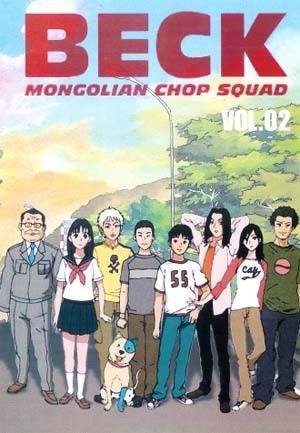“This World is Jam-Packed With Dark Nature Spirits!” COMICS! Sometimes I Have No Option But To Take Refuge In Fictional Horrors.
/こんにちは! Konnichiwa, culture vultures! This time out we spread our black, black wings and set our beady, dead eyes on the delightful island nation of Japan! Yes, Japan! Home of almost 200 volcanoes, a literacy rate of near 100%, the British car industry(*) and…MANGA! Japan! A tectonically unstable but most artistic archipelago indeed! Japan! Contra all those Jô Shishido (宍戸 錠) Yakuza movies Japan is one of the safest and least violent countries in the world, with as few as two gun-related homicides a year (Yes, America: two). Sometimes, though, such a haven of civility is fertile ground for horror. (SOCIOLOGICAL SPOILER: it’s probably the repression.) Hai! It’s Junji Ito (伊藤 潤二)! It’s Horror (帽子掛け)! It’s MANGA!!! It’s COMICS!!! (*) N.B. intended as timely BREXIT based satire not #CASUALRACISM.
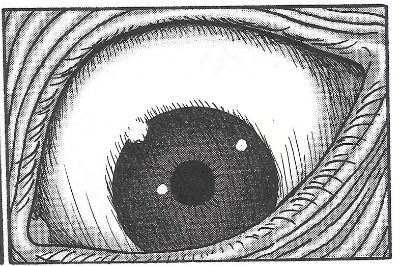 FRAGMENTS OF HORROR by Junji Ito
FRAGMENTS OF HORROR by Junji Ito
Anyway, this...
FRAGMENTS OF HORROR Story & Art By Junji Ito Translation & Adaptation by Jocelyn Allen Touch-up Art & Lettering by Eric Erbes Cover & Graphic Design by Sam Elzway Edited by Masumi Washington & Nick Mamatas (he writes real books too!) Fragments of Horror © Junji Ito 2014 Viz Media, $17.99(US), $21.00(CAN), £10.99(UK) (2015)
Yes, Manga! Better yet, Manga by Junji Ito (or 伊藤 潤二 or Itō Junji)! Recap: I don’t know anything about Manga. Which on one hand is good; I’m coming at it without preconceptions and my like or dislike is as pure as unicorn poop. On the other hand it isn’t so good, because there are a lot of Manga Experts out there, so I might find myself squealing delightedly over what is commonly considered by the cognoscenti to be the Manga equivalent of Rob Liefeld. Hypothetical elitist disdain be damned, I like Junji Ito (I’m sticking with that permutation of his name as it’s the one on the book). I liked GYO and UZUMAKI (both of which are currently available in one volume hardback editions from Viz. Plug! Plug! John sez, “Buy ‘em from Brian!”) and since Junji Ito was the one what did them, my picking up FRAGMENTS OF HORROR was as inevitable as death itself. But, y’know, a bit more fun.
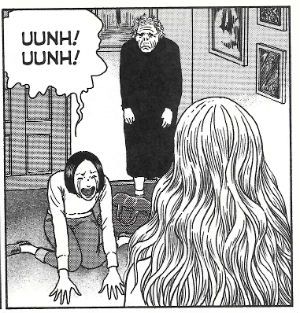 FRAGMENTS OF HORROR by Junji Ito
FRAGMENTS OF HORROR by Junji Ito
Physically FRAGMENTS OF HORROR is a sturdy medium sized hardback, sporting a thoughtfully designed dustjacket and cover combo (firm stock, silver ink, bas relief; suh-weet). As an object it feels like someone was, you know, bothered; which is nice. Oh, yeah, it reads right to left as is the habit of our Japanese chums, but don’t worry, you’ll soon crack the habit. And it’s worth the minuscule adjustment of optical tracking required because within are eight tales of fetid fun; ranging from the eerily affecting to the utterly repugnant, with the odd stop at Black Humourville along the way, just so it doesn’t all get a bit too much, a bit too one note. Junji Ito knows pacing isn’t just what you do in The Delivery Suite and Junji Ito also knows tone isn’t just short for Tony when you’re shouting across the pub. Which is more than can be said for most North American genre comics creators. As all those drunks in dated melodramas who put their boozy fists through accusatory mirrors can attest, fragments of anything which has shattered vary in size and sharpness. And so it is with these fragments of horror.
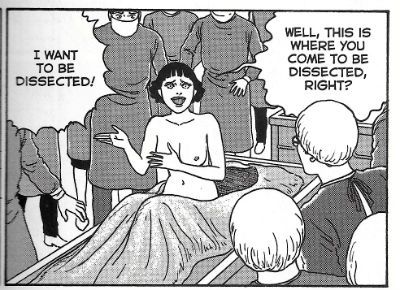 FRAGMENTS OF HORROR by Junji Ito
FRAGMENTS OF HORROR by Junji Ito
Ayup, it’s a horror anthology, so the tales are less than lengthy, thus I’ll have to skirt around too much detail while, hopefully, managing to give you a pungent enough tang of the pleasingly acrid taste of the ghastly goods on offer. And so in the order in which I happened to remember them:
Dissection-Chan: I don’t even know what this one is, well, except it’s horrible. Which is kind of the point of horror so: win. Playing doctors and nurses as kids isn't creepy enough for Junji Ito so the pair of tiny terrors herein go further and play coroners and corpse. But then they grow up and playtime turns into..well, precisley. It’s probably the kind of bilious bon-bon people pigeonhole as Ito-esque, being a kind of diseased shaggy dog story (a Cujo?) leading up to imagery Ito’s clearly built the whole thing around, and has obviously taken a quite excessive, if not unseemly, pleasure in delineating. I bet his talented little tongue was stuck out and he had his face about an inch from the paper; like when you used to do an ornately cross-hatched “Bub” from Day of The Dead (1985) on your rough book, while far away a voice droned interminably on about The Corn Laws and their perpetual Repeal.
Futon: The natural indolence of the typical young male is taken to horrific extremes in a story no doubt used by Japanese HR Departments to prevent the Western “duvet day” phenomenon gaining traction in their fine land.
Tomio/Red Turtleneck: Bizarrely this features the same young couple who were in ‘Futon’; weirder yet the bloke, Tomio, again taps off with a randy witch while the doughty lass, Madoka, has to cope with the malefic consequences. Psst! If you are called Tomio and are shacked up with a Madoka, and you know Junji Ito, uh, I don’t want to read too much into this but it probably couldn’t hurt if you scarpered sharpish because ol’ Junji’s got a Wagyu beef (和牛) with you. If you knicked his girlfriend and then cheated on her with a randy witch, well, I’d definitely consider going to ground under a fake name. Maybe put a continent or two between you. Open a bait and tackle shop and learn to enjoy solitude and sunrises. Better than waking up with scissors in your eyes. Anyway, Junji Ito’s vengeful fixations (legal note: I jest) aside this one is a darkly amusing tale of a shagabout whose big head suffers when he puts his little head where it shouldn’t have been. Namely, in a randy witch. Or is it all a manifestation of a castration complex brought on by guilt at dipping his wick in the randy witch? I don’t know and it doesn’t matter, because it definitely features a bit where a live cockroach is crammed into an open wound. Something for everyone in this 'un!
Wooden Spirit: The vast property porn audience of such UK televisual verrucae as Grand Designs (rich couple build unfeasibly expensive house shaped like an abstract philosophical concept) and Property Ladder (a pair of profoundly un-endearing estate agent “characters” help indecisive couples to buy a house, because apparently that’s entertainment) is catered to in a tale which combines erotica, architecture and the fairy tale trope of the evil stepmother. It’s a queasily eerie tale which is both timely and timeless, and one not recommended for people with a thing about eyes. Yes, EYES!
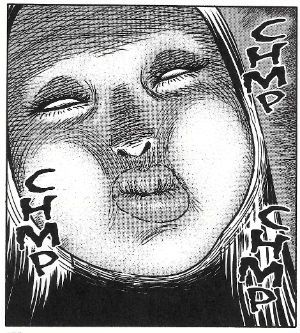 FRAGMENTS OF HORROR by Junji Ito
FRAGMENTS OF HORROR by Junji Ito
Blackbird: Survival at any price? is the question ‘Blackbird’ asks you, and it won’t stop staring at you accusingly until you answer in the affirmative, at which point it cackles so unnervingly you inadvertently let a bit of poop slip out. ‘Blackbird’ features the phantasmagorical sight of a bird with the face of Pete Burns (the recently deceased frontman of the band ‘Dead or Alive’. Or is that just ‘Dead’ now? Too soon, huh?) and then it gets seriously foul, before finally twisting your mind into strange new shapes so you can accommodate the thoughts it births.
Gentle Goodbye: Melancholy ghost story for anyone whose emotions are still functioning after the flaming shit pit that has been the year 2016. Beautifully and subtly done stuff. Not at all what people expect from Junji Ito, even though he’s as good at inducing quiet heart ache as he is at gooshy upchuckery.
Magami Nanakuse: Bizarre physical comedy ensues when a young fangirl meets her favourite author, only to discover s/he is a bit of a nutter. Which is unusual because writers are usually so well adjusted aren’t they? Probably works best if you know which author Ito is ripping the piss out of. Knowing his humility it's probably himself, but it doesn't seem like it. Let's pretend it's Neil Gaiman. See, now it's hilarious!
Whispering Woman: This is for all those middle class parents who palm the tricky business of bringing up their kid onto a paid stranger. Or maybe it’s about getting too involved in your work. It’s definitely about how people use kids to get back at other people, but here it’s in a savagely literal way. Kids always make horror worse don’t they? Unless you’re a sociopath. In which case, congratulations, 2016 is certainly your year!
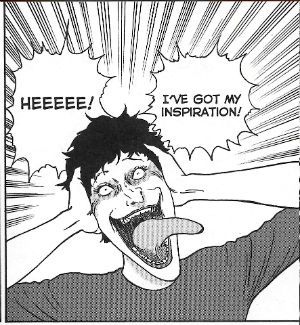 FRAGMENTS OF HORROR by Junji Ito
FRAGMENTS OF HORROR by Junji Ito
Aside from the ostensible subject matter part of the appeal of MANGA! for me is seeing tentacle rape, oops, no, wait, it’s seeing how people in Japan live (or lived if its LONE WOLF). All the little things the creators take for granted but strike me, some five thousand miles and change away, as odd. But not odd in a racist way, I hasten to add so swiftly I risk doing myself a mischief. Things like a young couple living in one room, a father and daughter living in a house so unchanged the government accord it “A Registerd Tangible Cultural Property” (like Howard Victor Chaykin!), the shape of the buses, the food on the plates (no chips?!), the boxy architecture, the fact that Louise Brooks’ bob rightly remains cross-cultural visual shorthand for sultry, the sense of family which is both impressive and oppressive, the sudden swathes of wild nature beyond the boxy cities with their chip deficient Louise Brookses riding differently-shaped buses to visit sour faced in-laws. Just, you know, the stuff of life; beige days. And it’s important not to underestimate the importance and skill of Junji Ito in creating a convincingly mundane environment. That way when the bad stuff turns up to tear it all up it resonates just that bit deeper, and just that shade darker. Sure, it takes some serious horror chops to get cosmic horror out of some idle arse staying in bed all day. But throw in a psychotropic fungus and a passing randy witch and you need to have a sturdy hook of reality from which to suspend your disbelief. Junji Ito’s hook is robust enough for even my handy-man dad to curtly nod in appreciation.
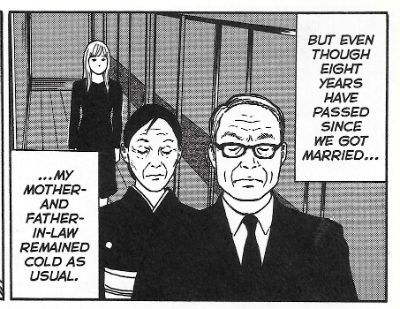 FRAGMENTS OF HORROR by Junji Ito
FRAGMENTS OF HORROR by Junji Ito
According to the ridiculously self-effacing note in the “back”, FRAGMENTS OF HORROR is Junji Ito’s return to the horror trenches after several years drawing cats and, uh, stuff. As diffident as the Japanese are reputed to be(#CASUALRACISM? Or #SWEEPINGGENERALISATION?) it seems ridiculous that someone at Junji Ito’s artistic level should be so, and so sincerely so at that. This isn’t a pose; the dude’s really unsure whether he provided satisfaction. He even thanks his editor for rejecting his first attempt at one strip and making him start from scratch. Can you imagine a Red Hot North American Genre Comics Creator doing that? They’d pitch a shit fit and it’d all end in tears and no mistake. Someone would be collecting their P45 and it wouldn't be the Red Hot North American Genre Comics Creator. Listen to an editor! Chance'd be a fine thing! While I found Junji Ito’s humility refreshing, I think I should just take this opportunity on the behalf of every man, woman and child in the West to say, don’t sweat it, Junji Ito, FRAGMENTS OF HORROR was VERY GOOD! Welcome back and don't be a stranger!
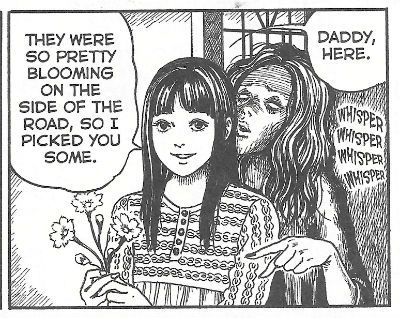 FRAGMENTS OF HORROR by Junji Ito
FRAGMENTS OF HORROR by Junji Ito
NEXT TIME: If we are all still above ground, some more reality avoidance via the medium of - COMICS!!!


